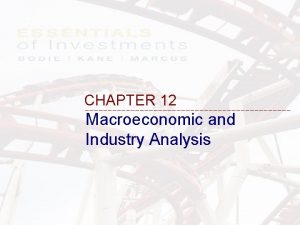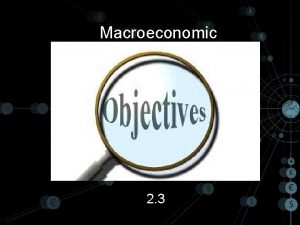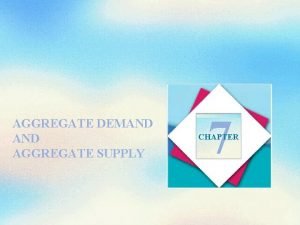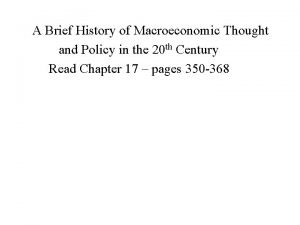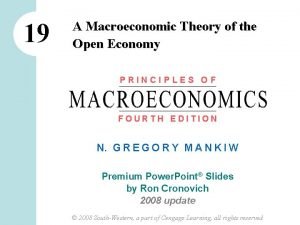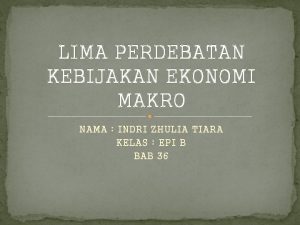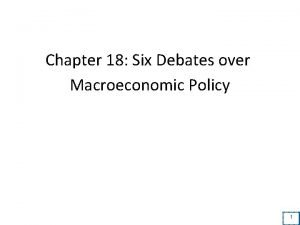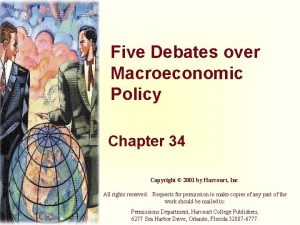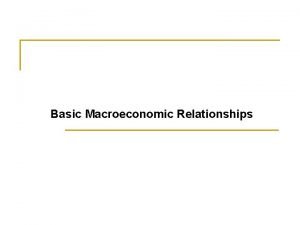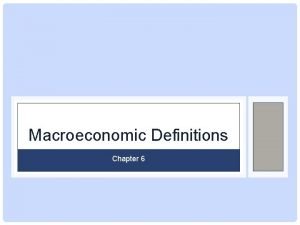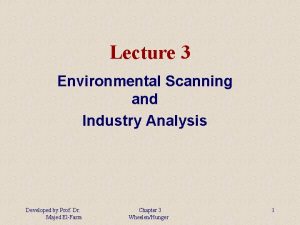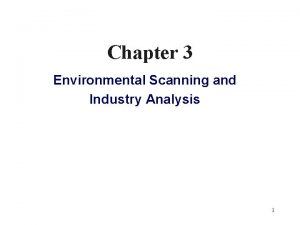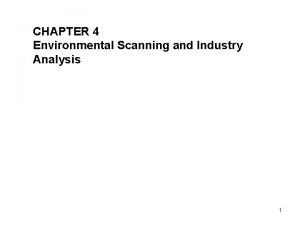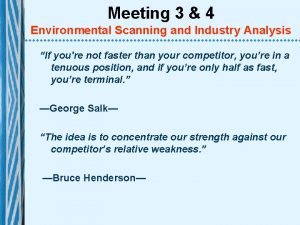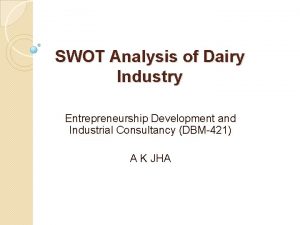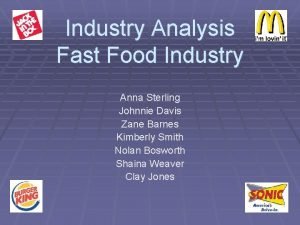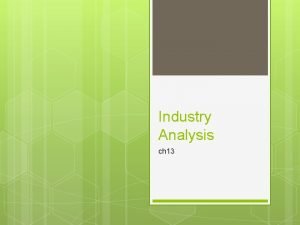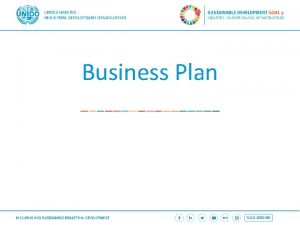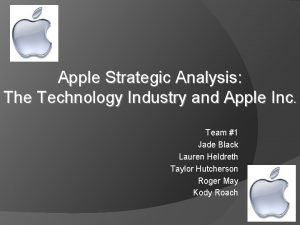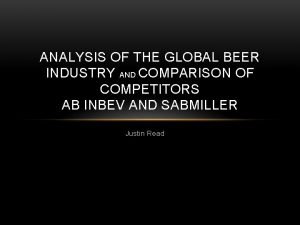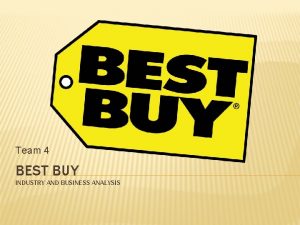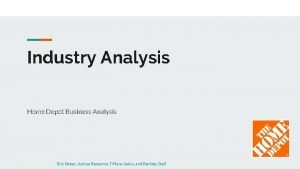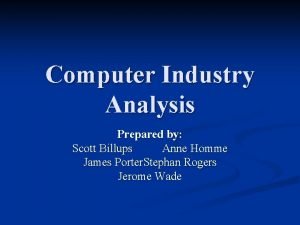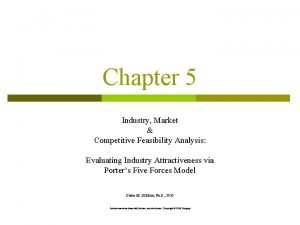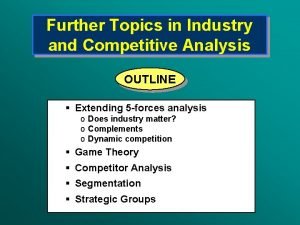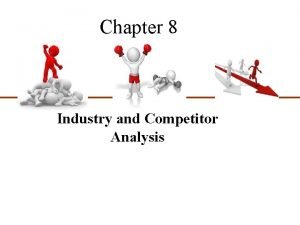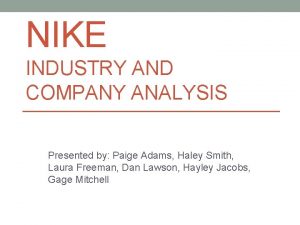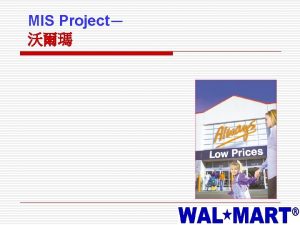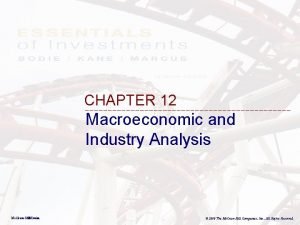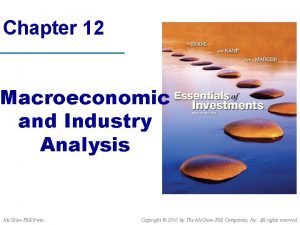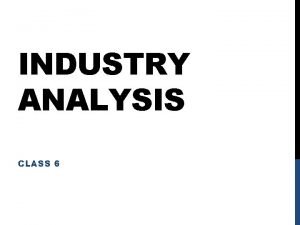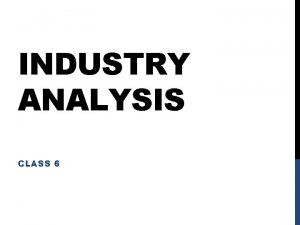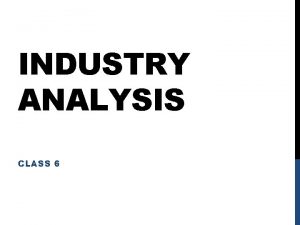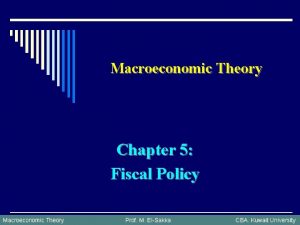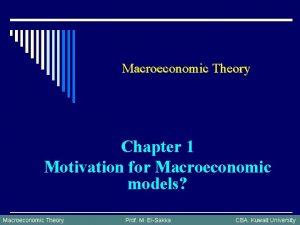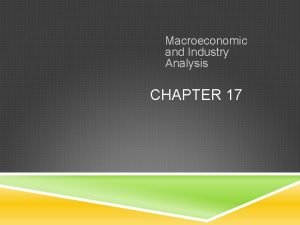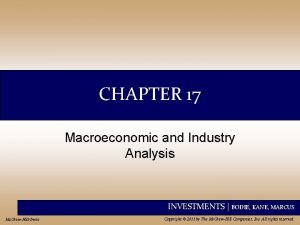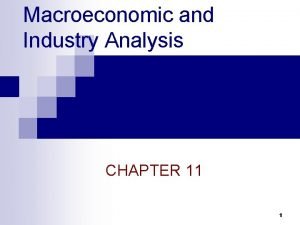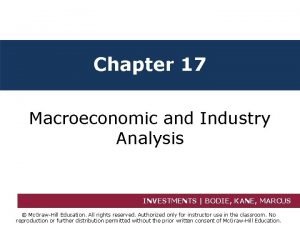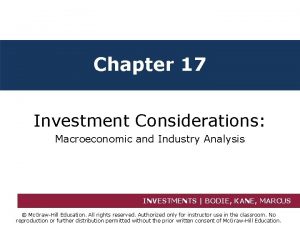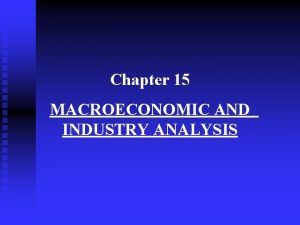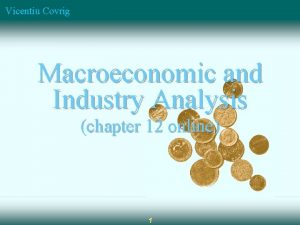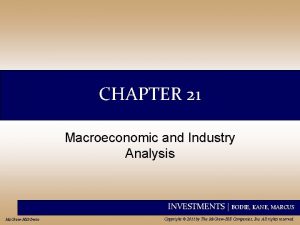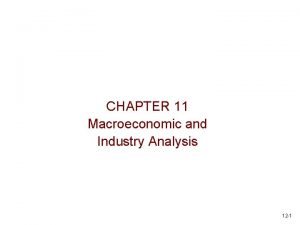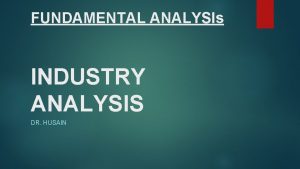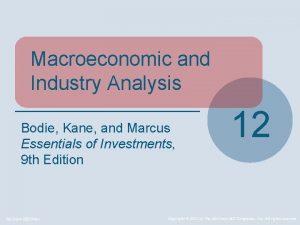Chapter 12 Macroeconomic and Industry Analysis Mc GrawHillIrwin




















































- Slides: 52

Chapter 12 Macroeconomic and Industry Analysis Mc. Graw-Hill/Irwin Copyright © 2010 by The Mc. Graw-Hill Companies, Inc. All rights reserved.

12. 1 The Global Economy 12 -2

Framework of Analysis • Fundamental Analysis – Analysis of the determinants of firm value, specifically attempting to forecast the earnings and dividends of a firm. – Top down approach: Analyze economy Analyze industry Analyze firm 12 -3

Framework of Analysis • Approach to Fundamental Analysis – Domestic and global economic analysis • Performance in countries and regions is highly variable • Politics affects the economy 12 -4

Framework of Analysis • Approach to Fundamental Analysis – Foreign exchange rates affect U. S. firms and their competitors • How are the following affected by a change in the value of the dollar? – Ski resort in Aspen Colorado – Profits of Rocky Mountain Log homes, an exporter of log homes around the world – Yen profit on sale of Toyota cars in U. S. 12 -5

Exchange Rate Risk • Exchange rate risk can affect: – Sales – Profits – Stock returns 12 -6

Framework of Analysis • Approach to Fundamental Analysis – Industry analysis • Critical to understand the competitiveness of the industry – Company analysis • Detailed strategic and financial analysis of the firm • Why use the top-down approach? 12 -7

Table 12. 1 Economic Performance, 2008 12 -8

Figure 12. 1 Change in Real Exchange Rate: Dollar Versus Major Currencies. 1999 -2008 12 -9

12. 2 The Domestic Macroeconomy 12 -10

Key Economic Variables • Gross domestic product – The market value of gods and services produced domestically in a given time period • Unemployment rate – The ratio of number of people classified as unemployed to the total labor force • Inflation – The rate of change in the general price level as measured by some price index: • Consumer Price Index • Producer Price Index • GDP Deflator 12 -11

Key Economic Variables • Interest rates – Major impact on security prices (stocks and bonds) and the level of economic growth • Budget Deficits – The budget deficit is the amount by which government spending exceeds government revenues – Budget deficits can crowd out private investment, private investment generates more growth than public sector investment. – Alternative to crowding out is overreliance on foreign borrowing. 12 -12

Key Economic Variables • Consumer sentiment – Consumers’ optimism or pessimism concerning the economy and job prospects. Source: Federal Reserve Bank of St. Louis, National Economic Trends, May 2009 12 -13

Figure 12. 2 S&P 500 Versus EPS Estimate 12 -14

12. 3 Interest Rates 12 -15

Factors Determining the Level of Interest Rates 1. Supply of funds from savers 2. Demand for funds from businesses 3. Government’s net supply and/or demand for funds – Fiscal policy – Monetary policy 4. Expected rate of inflation – Interest rates contain a premium for expected inflation – The Federal Reserve typically raises interest rates proactively when inflation is expected to increase 12 -16

Figure 12. 3 Determination of the Equilibrium Real Rate of Interest How would an increase in the government budget deficit affect the equilibrium interest rate? If the Federal Reserve wishes to stimulate growth how would they choose to affect the money supply? Would it work? 12 -17

12. 4 Demand Supply Shocks 12 -18

Demand Shocks • Demand Shock – An event that affects the demand for goods and services, some examples include: • • Change in tax rates Change in the money supply Change in government spending Change in foreign export demand 12 -19

Supply Shocks • Supply Shocks – An event that influences production capacity and input costs, including labor costs, examples include • • • Changes in the price or availability of imported oil Freezes Floods Droughts Changes in wage rates – Negative supply shocks tend to result in demand > supply, which is inflationary. Negative supply shocks also may result in reduced output, leading to slower economic growth. 12 -20

Tie to investments Choose industries that will be helped by your expected economic scenario and avoid those that will be hurt. – For example, choose consumer cyclicals if the economy is projected to do well, but not if the economy will weaken, – May choose consumer staples and necessities such as utilities if the economy is not expected to do well. To earn abnormal returns you must have better information (unlikely) or better analysis than the competition. 12 -21

12. 5 Federal Government Policy 12 -22

Fiscal Policy • Government spending and taxing actions to stabilize or spur growth in the economy – Most direct policy method in terms of its effect on the economy (Keynesian policy) – Often implemented too slowly due to political process – Leaky budget analogy – Poor means to fine tune an economy, can be inflationary – May be necessary when monetary policy is ineffective such as in the Financial Crisis of 2008 12 -23

Monetary Policy • Manipulation of the money supply to influence economic activity by influencing the demand for goods and services to be produced and consumed – Initial & long run effects – Potentially long lags – Changes incentives to purchase and invest, but may not lead to desired effect on demand 12 -24

Monetary Policy • Tools of monetary policy – Open market operations (federal funds rate) – Discount rate – Reserve requirements 12 -25

Supply-Side Policies • Supply-siders focus on incentives and marginal tax rates • Lowering tax rates tends to – encourage more investment – Improve incentives to work – generate faster economic growth • “Lift all boats” Can we rely solely on supply side policies in a severe recession such as the Financial Crisis of 2008? 12 -26

Supply-Side Policies • Income inequality may also rise – Those with better ideas, education, opportunities, work ethic, providence, etc. will do better, others may not. – If the majority are better off, but some much more so than others does this indicate that we should not use supply side policies? 12 -27

12. 6 Business Cycles 12 -28

The Business Cycle • Recurring patterns of recession and recovery – Peak – Trough • Industry relationship to business cycles – Cyclical industries • Industries with above average sensitivity to the state of the economy – Defensive • Industries with below average sensitivity to the state of the economy 12 -29

Economic Indicators • Leading Indicators - tend to rise and fall in advance of the economy 12 -30

Economic Indicators (cont) • Coincident Indicators - indicators that tend to change at the same time as the economy 12 -31

Economic Indicators (cont) • Lagging Indicators - indicators that tend to follow or lag economic performance 12 -32

Cyclical Indicators 12 -33

Other Indicators 12 -34

Figure 12. 6 Economic Calendar at Yahoo! 12 -35

12. 7 Industry Analysis 12 -36

Industry Analysis • Performance can vary widely across industries – It is difficult to find a good stock in a poor industry 12 -37

Figure 12. 8 Industry Stock Price Performance, 2008 12 -38

Defining an Industry • It can be difficult to define an industry – North American Industry Classification System (NAICS) attempts to define industry groups with a four or five digit code: • The first two digits broadly define the industry group: NAIC code 23 = construction • The last two or three digits define the industry more narrowly 12 -39

Example of NAICS Industry Codes 12 -40

Figure 12. 9 ROE of Application Software Firms, 2008 12 -41

Sensitivity to Business Cycle • Factors affecting sensitivity of earnings to business cycles – Sensitivity of sales of the firm’s product to the business cycles – Fixed costs and leverage • Fixed costs are costs that do not vary with the level of production. • Fixed costs contribute to higher profitability when sales are high, but will result in lower profitability when sales are lower. 12 -42

Sensitivity to Business Cycle – Operating leverage • Proportion of fixed operating costs as a percent of total costs • Greater operating leverage results in greater swings in profits over the business cycle – Airlines, automobiles – Financial leverage • Proportion of fixed financing costs as a percent of total costs • Greater financial leverage results in greater swings in profits over the business cycle – Airlines, banks, investment banks 12 -43

Figure 12. 10 Industry Cyclicality 12 -44

Figure 12. 11 A Stylized Depiction of the Business Cycle 12 -45

Sector Rotation Selecting Industries in line with the stage of the business cycle: natural resource firms • Peak defensive firms • Contraction equipment, transportation and construction firms • Trough cyclical industries • Expanding 12 -46

Figure 12. 12 Sector Rotation Illustrated 12 -47

Industry Life Cycles Stage Start-up Consolidation Maturity Relative Decline Sales Growth Rapid & Increasing Stable Slowing Minimal or Negative 12 -48

Figure 12. 13 The Industry Life Cycle 12 -49

Industry Structure and Performance (Porter Model) Determinants of Industry Competition and Profitability • Threat of Entry – New entrants reduce profitability – Barriers to entry preserve profitability • • • Large scale required to be profitable (autos) Secure distribution channels Brand loyalty, unique differentiated product Proprietary production technology Intellectual property protections Learning curve effects 12 -50

Industry Structure and Performance (Porter Model) Determinants of Industry Competition and Profitability • Rivalry between existing competitors – Equal competitors reduce profitability – Slow industry growth, Pressure to – High fixed costs, cut prices – Scale economies, 12 -51

Industry Structure and Performance (Porter Model) Determinants of Industry Competition and Profitability • Pressure from substitute products – Substitutes limit profitability (propane, natural gas) • Bargaining power of buyers – A buyer that purchases a large percent of an industry’s output can limit the selling industry’s profitability (auto parts suppliers) • Bargaining power of suppliers – A supplier that controls a key input can limit the buying industry’s profitability (labor unions) 12 -52
 Macroeconomic and industry analysis
Macroeconomic and industry analysis Unemployment
Unemployment Five debates over macroeconomic policy
Five debates over macroeconomic policy Macroeconomic equilibrium occurs:
Macroeconomic equilibrium occurs: Macroeconomic deals withसमग्रलक्षी
Macroeconomic deals withसमग्रलक्षी History of macroeconomic thought
History of macroeconomic thought A macroeconomic theory of the open economy
A macroeconomic theory of the open economy Perdebatan kebijakan makro ekonomi
Perdebatan kebijakan makro ekonomi Six debates over macroeconomic policy
Six debates over macroeconomic policy 5 debates over macroeconomic policy
5 debates over macroeconomic policy Five debates over macroeconomic policy
Five debates over macroeconomic policy Basic macroeconomic relationships
Basic macroeconomic relationships Macroeconomic definitions
Macroeconomic definitions Industry and competitor analysis
Industry and competitor analysis Environmental scanning and industry analysis
Environmental scanning and industry analysis Environmental scanning and industry analysis
Environmental scanning and industry analysis Environmental scanning and industry analysis
Environmental scanning and industry analysis Environmental scanning and industry analysis
Environmental scanning and industry analysis Chapter 18 industry and urban growth
Chapter 18 industry and urban growth Swot analysis of gaming industry
Swot analysis of gaming industry Swot analysis of dairy farming
Swot analysis of dairy farming Dormant stakeholder
Dormant stakeholder Social business plan
Social business plan Burger industry analysis
Burger industry analysis Process of industry analysis
Process of industry analysis Hisrich and peters business plan
Hisrich and peters business plan Industry analysis in business plan
Industry analysis in business plan Apple industry overview
Apple industry overview Pestel analysis beer industry
Pestel analysis beer industry Best buy industry analysis
Best buy industry analysis Indian plastic industry analysis
Indian plastic industry analysis Industry analysis definition
Industry analysis definition Home depot strengths
Home depot strengths Swot analysis of mice industry
Swot analysis of mice industry Scott billups
Scott billups Competition feasibility study
Competition feasibility study Product desirability and product demand
Product desirability and product demand Swot analysis of apparel industry
Swot analysis of apparel industry Industry analysis outline
Industry analysis outline Industry analysis outline
Industry analysis outline Gumshoe research example
Gumshoe research example Strategic industry analysis
Strategic industry analysis Objective of industry analysis
Objective of industry analysis Crescent textile mills company profile
Crescent textile mills company profile Nike company analysis
Nike company analysis Physical therapy industry analysis
Physical therapy industry analysis Under armour mission statement
Under armour mission statement Walmart
Walmart Taco rico menu
Taco rico menu Wireless telecommunications industry analysis
Wireless telecommunications industry analysis Cupcake industry analysis
Cupcake industry analysis Chapter 4 the triumph of industry
Chapter 4 the triumph of industry Chapter 4 the horticulture industry answer key
Chapter 4 the horticulture industry answer key
